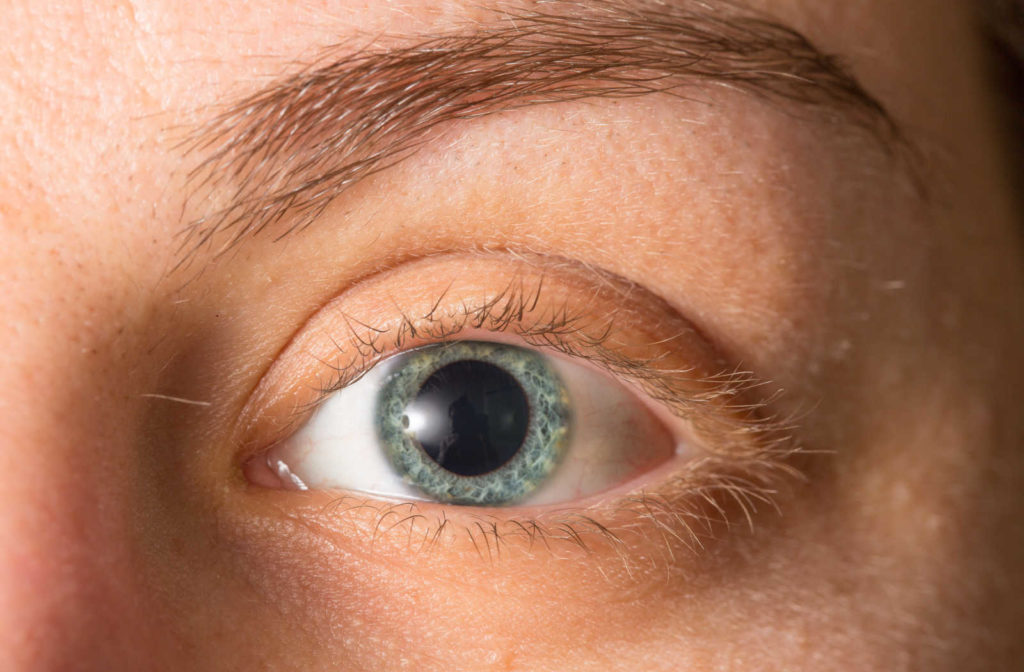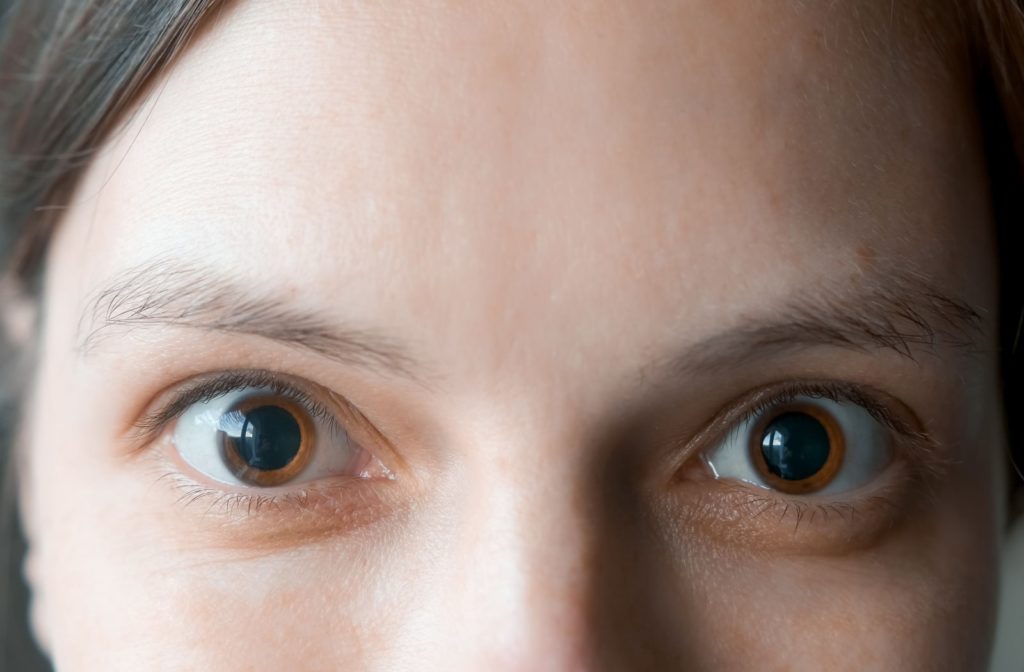Many patients wonder if they can drive after their eyes are dilated. Eye dilation drops need 20-30 minutes to take effect and usually impact vision for 4-6 hours afterward. Some patients might feel the effects for up to 24 hours. This creates a challenge for people who drive themselves to eye appointments.
Your vision becomes noticeably blurry after dilation. Bright light bothers your eyes more than usual, which makes driving risky. A study showed that twenty patients felt discomfort from glare after dilation. Three of them specifically mentioned trouble driving because of it. The effects vary by a lot from person to person. Some lucky patients recover in just 45 minutes, while others might have dilated pupils until the next day.
These safety concerns are real. Dilated eyes make it harder to see clearly, and light appears much brighter than normal, especially in sunlight. You need to understand how long dilation lasts and know the right time to drive again after your eye exam.

What Happens During Eye Dilation
Eye dilation does more than just make your pupils bigger—it’s a significant medical procedure that lets doctors see hidden parts of your eyes. Let me get into this common yet important part of detailed eye examinations.
Why doctors dilate your pupils
Your eye’s dilation gives doctors a clear view of your eye health. Eye doctors can only check a small part of your eye without it—it’s like “looking through a peephole when you want to look through a big window”. A dilated exam helps doctors get a full picture of critical eye structures including the retina, optic nerve, and blood vessels.
This procedure helps diagnose many eye conditions that don’t show early warning signs. It also helps spot signs of health issues like diabetes and high blood pressure that change blood vessels—changes you can only see with dilated eyes. Research from the American Academy of Ophthalmology shows that regular dilated eye exams can prevent 95% of diabetes-related vision loss.
What the drops do to your eyes
The sort of thing I love about dilation drops is how they work. These medications target two key muscles in your iris—the colored part of your eye. We used them to block the parasympathetic receptors in the iris sphincter muscle (arranged in a circular pattern like a purse string), which stops it from contracting. The iris dilator muscle (arranged in a radial pattern) works without opposition because this muscle can’t constrict the pupil, and this makes the pupil larger.
Eye doctors often use medications like Tropicamide that temporarily stop the muscles controlling pupil size and focusing ability. These drops come in different strengths based on what the exam needs. To name just one example, see Tropicamide in 0.5% and 1.0% concentrations—both dilate pupils the same way, but the stronger version blocks focusing more effectively.
Your doctor starts by putting drops in your eyes. You’ll feel a slight sting as the medication works. Your pupils will open fully after 20-30 minutes, letting much more light enter your eyes.
How long does eye dilation last
Different people’s eyes stay dilated for different lengths of time. Most adults’ dilation lasts 4-6 hours. In spite of that, this time can stretch from 4 to 24 hours based on several factors.
Your eye color plays a big part in dilation time. People with lighter-colored eyes (blue, green, or hazel) dilate faster and stay dilated longer than those with darker eyes. This happens because lighter irises have less melanin and react more to dilating drops.
The type and strength of dilating drops also affect how long dilation lasts. Tropicamide (used in routine dilation) usually wears off in 4-8 hours, but some people’s eyes might stay dilated up to 24 hours. Stronger medications like Atropine can make dilation last even longer.
Age affects dilation time too. Children need stronger drops because their eye muscles work harder, so their dilation might last more than 24 hours. Parents often notice their child’s pupils staying large until the next day after seeing the eye doctor.
How Dilation Affects Your Vision
Pupil dilation changes how you see things and affects your daily activities. These changes explain why some tasks become harder after an eye exam.
Blurry near vision vs. clear distance vision
Most patients notice their close-up vision gets blurry after dilation, but they can still see things far away clearly. This happens because dilating drops temporarily stop the focusing muscle inside your eye (ciliary muscle) from working. You’ll find it hard to focus on things close to you like books, phones, or computer screens.
Your pupil size affects how well you see and your depth of field. Larger pupils during dilation narrow your depth of field, so objects look clear only at certain distances. Smaller pupils help you see objects clearly across more distances. This makes reading and other close-up tasks really tough after dilation.
Daily tasks become challenging, like:
- Reading text messages or emails
- Viewing computer screens
- Reading books or documents
- Seeing price tags while shopping
Increased light sensitivity and glare
Dilated pupils can’t shrink in bright light like they normally would. More light enters your eyes, making them sensitive and causing glare. Research shows that dilated pupils make it harder to spot low-contrast hazards, reduce visual sharpness, and make glare much worse.
Larger pupils let more scattered light in, which causes more discomfort. Bright sunlight and headlights become really bothersome. Research found that half the people studied said dilation affected their driving, mostly because of increased glare sensitivity.
Sunglasses help block extra light and reduce discomfort after dilation. The sensitivity stays until the drops wear off, even with sunglasses on.
How long do eyes stay dilated
Most adults’ eyes stay dilated for 4 to 6 hours. Several things affect this timeline:
Eye color makes a big difference. People with light-colored eyes (blue, green, or hazel) stay dilated longer than those with darker eyes. Light irises have less pigment to absorb the dilating medication.
Age plays a key role too. Children need stronger drops because they have stronger focusing muscles. Their eyes might stay dilated for a full day. Sometimes, dilation lasts more than 24 hours in kids.
The type of eye drops used matters as well. Different drops have varying strengths and lasting effects. Eye doctors sometimes use stronger drops for specific tests or treatments, which means longer dilation times.
Without doubt, knowing these factors helps you plan better after your eye exam, especially if you need to drive.
Can You Drive After Eye Dilation?
People who get their eyes dilated often wonder if they can safely drive afterward. This question affects millions of patients each year who need to decide about driving home after their eye exam.
Can you drive with dilated eyes?
Driving with dilated pupils creates several safety risks. Your eyes become extra sensitive to bright lights, which leads to more glare and makes it harder to focus – both during day and night. This sensitivity slows down your reaction time when you need to respond to road hazards.
Dilated pupils mess with your depth perception and make it hard to judge the space between your car and other objects. This affects crucial decisions about when to brake or switch lanes. Your peripheral vision also takes a hit, which means you might miss seeing cars, people, or obstacles around you.
Research on driving after dilation shows specific challenges like:
- Problems seeing traffic lights clearly
- Difficulty reading signs on the road
- Trouble figuring out distances correctly
What doctors say about driving post-dilation
Doctors don’t all agree completely about driving after dilation, but most lean toward playing it safe. The American Academy of Ophthalmology states “It may not be safe to drive yourself after having your eyes dilated”. The Mayo Clinic and many eye doctors suggest getting someone else to drive you home after your appointment.
Eye care experts usually stick to the “better safe than sorry” approach. A retina specialist puts it this way: “While many patients may be fine driving after dilation, others may not realize there is a problem until it’s too late”. This uncertainty remains the biggest problem for medical professionals.
The weather, traffic, how far you need to go, and what time it is all matter for safety. Bright sun or heavy traffic naturally makes driving riskier with dilated eyes than a quick trip on familiar streets when it’s cloudy.
How long after eye dilation can you drive
Most experts say you should wait 4-6 hours before driving after getting your eyes dilated. Your pupils slowly return to normal size and function during this time. Everyone reacts differently to dilation – personal factors really affect recovery time.
Your age makes a big difference in how dilation impacts your driving. Older patients usually see more noticeable effects than younger ones. People with darker eyes typically get back to normal faster than those with lighter eyes.
Time isn’t the only factor to think about. Here are signs that tell you it’s not safe to drive yet:
- You can’t read street signs clearly
- Lights still bother your eyes too much
- You have trouble telling how far things are
- Your eyes feel uncomfortable or unusually dry
Medical experts agree – if things still look blurry or lights bother you, wait to drive no matter how long it’s been. Yes, it is clear what eye care professionals think: don’t drive until your vision is completely back to normal.

Factors That Influence Driving Safety
Your safety while driving with dilated eyes depends on many personal and environmental factors. These variables help determine how long you should wait before driving, beyond the usual dilation effects.
Your age and eye color
Your physical traits affect how long dilation impacts your vision. People with lighter colored eyes experience dilation effects longer than those with darker eyes. This occurs because lighter irises have less melanin to absorb the dilating medication.
Age affects your vision’s response to dilation. Children need stronger dilating drops because their focusing mechanism works better, which means dilation could last up to 24 hours. Young patients should take extra care before they return to their regular activities.
Weather and lighting conditions
The weather and light outside affect how safe it is to drive after dilation. Bright sun makes sensitivity worse, while cloudy skies might help. Research shows that daytime driving with dilated eyes makes it harder to see and avoid hazards on the road.
When you schedule your appointment matters. Night driving becomes more challenging because headlights create intense glare and halos. Rain, fog, or snow make it even harder to see clearly – these are the same visual skills that dilation already affects.
Existing eye conditions like cataracts or glaucoma
Eye conditions you already have make driving with dilated pupils more difficult. Patients who have cataracts or glaucoma start with compromised vision, and dilation makes things worse. This combination increases risk levels dramatically.
First-time dilation vs. experienced patients
Your first dilation experience is quite different from later ones. New patients can’t predict how dilation will affect their vision or recovery time. That’s why eye doctors usually tell first-time patients to bring someone else to drive them home.
Experience doesn’t guarantee safety. Research shows that almost everyone with dilated pupils reported some visual disturbance. Half of the study’s participants felt dilation affected their driving, mostly because of increased sensitivity to glare.
Tips for a Safer Ride Home
A safe journey home after an eye dilation appointment needs good planning. Your dilated pupils create visual challenges that make safety precautions crucial for you and other road users.
Bring sunglasses to reduce glare
Sunglasses become your best defense after eye dilation. Your dilated pupils can’t control incoming light without proper protection, which makes them very sensitive to brightness. UV-protected wraparound styles work best to reduce glare and shield your eyes from harmful rays.
Sunglasses help reduce the discomfort from headlights and sunlight, so you’ll see the road better if driving becomes necessary. A wide-brimmed hat paired with your sunglasses offers maximum protection.
Wait in the clinic before driving
Your patience makes a difference after eye dilation. You should think about staying in your doctor’s waiting area until the effects start wearing off if time allows. The dilation effects usually decrease within a few hours, which creates safer driving conditions.
This extra time lets you check how comfortable your vision feels in a safe environment first. Many patients find this brief wait makes their drive home much safer and more comfortable.
Ask someone to drive you home
The safest choice after eye dilation remains alternative transportation. Eye care experts strongly suggest letting a friend or family member take you home after your appointment.
Here are some other options to think about:
- Use rideshare services like Uber or Lyft
- Take public transportation where available
- Walking with sunglasses might work for nearby places
Many eye professionals advise against immediate driving after dilation and say “it is always best to arrange for alternative transportation”.
Avoid driving at night or in unfamiliar areas
Dilated eyes face unique challenges during night driving. Light sensitivity increases significantly, which makes headlights and street lights more problematic. This heightened sensitivity might cause temporary blindness or make it hard to see objects on the road.
Familiar routes become your best choice if you must drive. New areas need extra visual focus and quick decisions – abilities that dilation affects. Bad weather like rain or snow makes everything more difficult, so it’s better to delay trips during rough weather.
Summing all up
Eye dilation is a vital medical procedure doctors use to spot vision problems and serious health issues. The temporary vision problems it causes raise real safety concerns for patients who drive to their appointments. Your age, eye color, and the type of drops used can affect how long you experience blurry near vision, light sensitivity, and depth perception issues – anywhere from 4 to 24 hours.
The best way to stay safe after eye dilation is to have someone else drive you home. You should wait at least 4-6 hours before driving if you have no other option. Quality sunglasses help reduce glare and sensitivity while your eyes recover. Make sure you feel completely comfortable with your vision before you decide to drive.
Patients getting their eyes dilated for the first time need to be extra careful since they don’t know how their body will react. People with existing eye conditions face even greater risks that make driving dangerous. Weather plays a big role too – bright sun, nighttime reflections, or rain make it harder to see with dilated pupils.
Your safety and that of other drivers should be your top priority. Eye dilation might disrupt your schedule briefly, but it’s a significant part of protecting your long-term eye health. Try to schedule your next eye appointment at a time when you won’t need to drive afterward. Both your vision health and driving safety need equal attention.
Here are some FAQs about if can you drive after eye dilation:
How long after pupil dilation can I drive?
Most eye doctors recommend waiting 4-6 hours before driving after eye dilation when your vision returns to normal. The exact time for how long after eye dilation can you drive depends on the type of drops used and your individual sensitivity. You should only consider when can you drive after eye dilation once your pupils have noticeably constricted and glare sensitivity has diminished.
What not to do after eye dilation?
After dilation, avoid activities requiring sharp vision like driving (can you drive after eye dilation is a common concern) or operating machinery until effects wear off. Don’t rub your eyes excessively or try to read small print immediately after the procedure. It’s also wise to avoid bright sunlight without protection when wondering can you drive home after eye dilation isn’t yet safe.
Can I drive after eye dilation in the UK?
UK driving laws caution against operating vehicles while vision is impaired, making can I drive with dialated eyes generally inadvisable. The Royal College of Ophthalmologists suggests waiting until how long until you can drive after eye dilation reaches the point where your vision is completely clear. Many UK clinics won’t discharge patients until they confirm it’s safe for can you drive home after eye dilation considerations.
What is the fastest way to recover from eye dilation?
While there’s no instant cure, using lubricating eye drops and resting in dim light can help speed recovery when determining how long after eye dilation can you drive. Some patients find gently massaging the tear ducts (where drops were applied) helps reduce dilation duration. However, even with these methods, can you drive after eye dilation should only be considered once vision fully normalizes.
Can I go to sleep after eye dilation?
Yes, you can safely sleep after eye dilation, though this won’t necessarily accelerate how long until you can drive after eye dilation recovery time. Sleeping may actually help pass the time while waiting for when can you drive after eye dilation becomes possible. Just be aware your vision may still be blurry upon waking if the drops haven’t fully worn off.
What happens if I don’t wear sunglasses after dilation?
Skipping sunglasses after dilation increases light sensitivity and discomfort, though it doesn’t directly affect how long after eye dilation can you drive timelines. Without protection, bright light can cause squinting and headaches, making activities like can you drive home after eye dilation even more challenging. Prolonged UV exposure while dilated may also temporarily increase eye strain.









